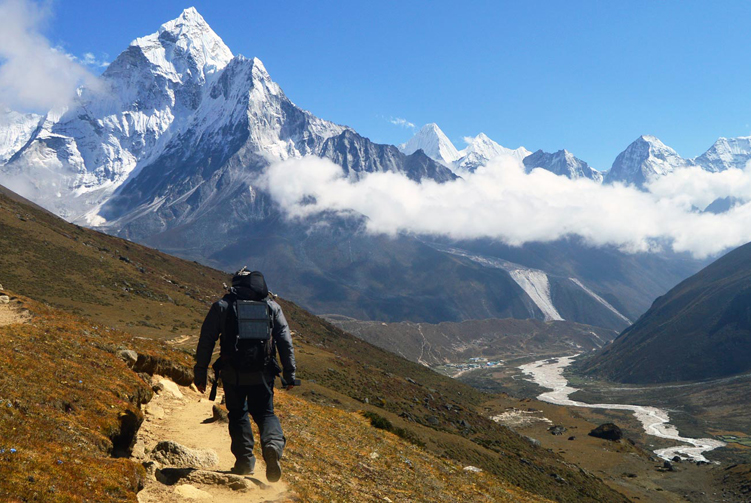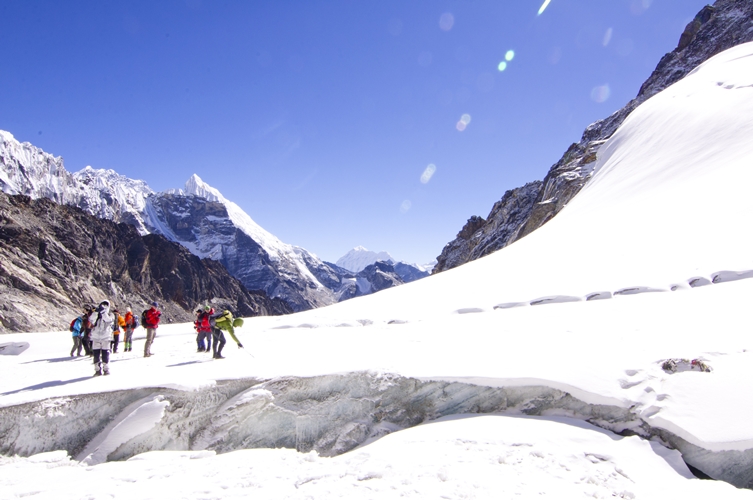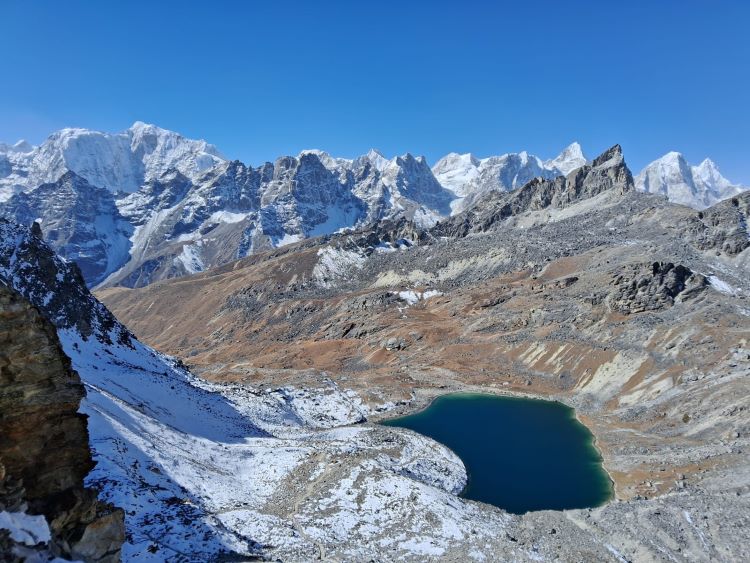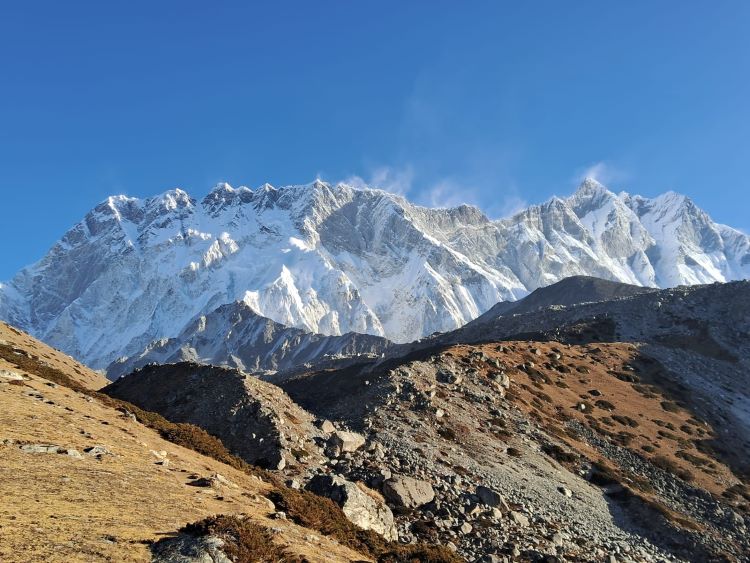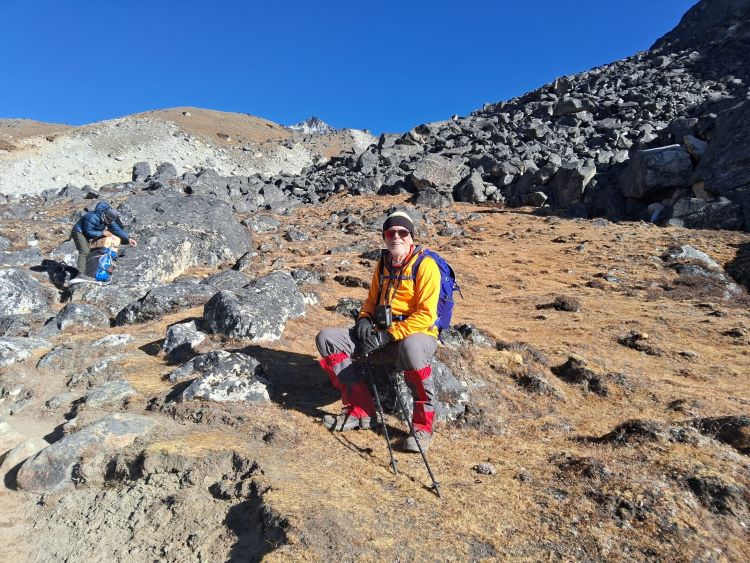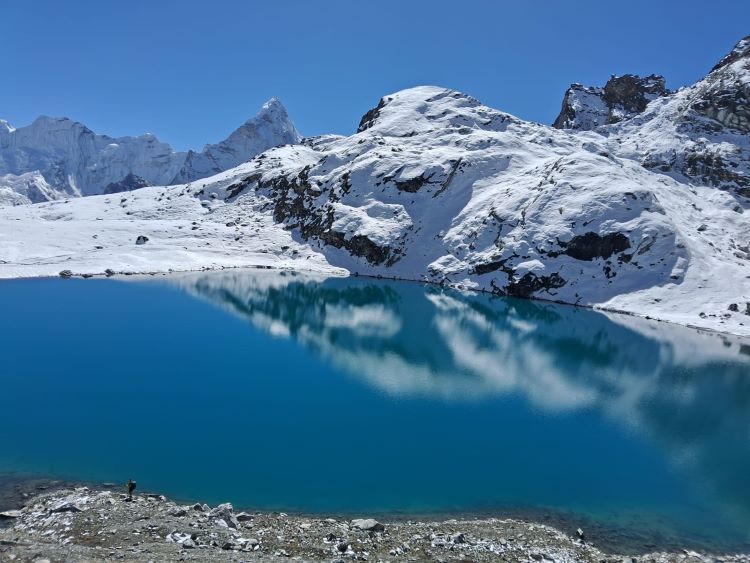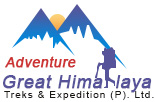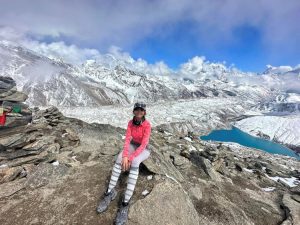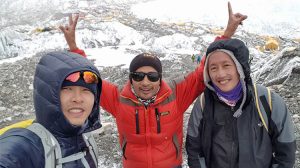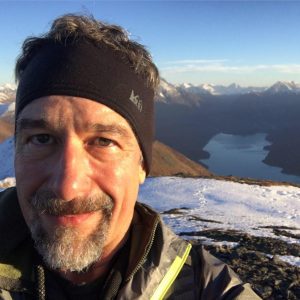Everest Base Camp Trek With Gokyo lake
Everest Base camp Trek Packages, High Pass Trekking In Nepal, Mount Everest Trekking & Tours
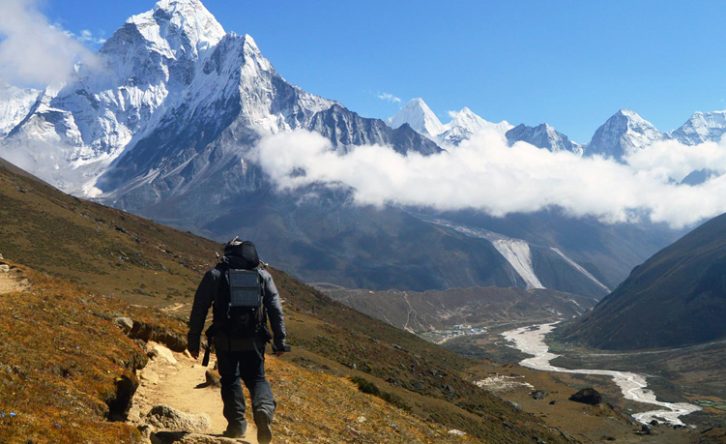
Overview
Everest base camp Trek With Gokyo lake is one of the challenging adventure trekking in Mt Everest trekking region. The trek combines spectacular viewpoints and enthralling sights of world’s tallest mountain such as Everest base camp ( 5356m, The famous Mt Everest sunrise view point (Kalapther 5545) crossing chola ( 5367 m) and Gokyo lake, Gokyo ri ( 5467m ) This trek is for people who want to experience the Everest Base camp trek with added benefits.
The 18 days Everest base camp & gokyo lake trekking via cho la pass, starting from lukla after 40 minutes flight Kathmandu. the trek takes you Everest base camp and kalapather first, then after cross cho la pass and gokyo lakes.the highlight of trek fabulous close-up views of Mt. Everest while the gorgeous Gokyo Ri presents views of the Gokyo valley, which is one of the Himalayas’ unsung treasures, the massive Ngozumpa Glacier and scenic vistas of the Himalayan peaks.
A trek to Everest Base Camp tops the bucket list for many trekkers. And the reason is obvious. The trail meanders along the foot of snow giants and the views of Everest and other imposing peaks are simply astonishing. And adding Gokyo & Cho La pass makes it magical.
Everest Base camp Trekking With Gokyo Lake is demands good physical shape: you must be able to walk for 6 – 7 hours a day on rugged mountain terrain. If you are in doubts to your physical ability, No Problem, Our professional mountain guide and staff will handle everything; they understands your interest, needs and above all take care of your safety along the way. We will ascend gradually making sure that we avoid mountain sickness and acclimatize as per schedule.
What You Can Expect An EBC Trek With Gokyo Lake
- Scenic & adventurous flight to and from Lukla
- Cross cultural privilege with the mountain people in the heart of Everest
- The sparkling turquoise-tinted Gokyo Lakes
- Magnificent views of Khumbu Glacier and Ice fall
- Everest Base Camp at 5,364m
- Standing Three viewpoints for overview Himalayas – Chukung Ri ( 5550m) Kalapatthar (5,545m) and Gokyo Ri (5,483m)
- Crossing and Waling to Ice Glacier, The Challenging Cho La Pass (5420m)
- Visit the Sacred Tengboche Buddhist Monastery
How hard EBC Trek With Gokyo Lake
Everest Base Camp and Gokyo Lake Trek is one of the adventurous and rewarding trek of the Nepalese Himalayas. It follows the traditional Everest Base Camp trekking trail and branches off to Gokyo Lakes via thrilling Cho La Pass. This is an adventure that demands greater physical endurance and tough mental grit. The terrain is diverse ranging from steep inclines and drops to stony trails and glacial crossings that are demanding even for seasoned trekkers. The Cho La Pass (5,420 m) route is particularly challenging because of the icy landscape and uncertain weather and needs specialized gear and experience in high altitude trekking.
Altitude sickness is also a serious challenge which is common because the trek ascends beyond 5,000 meters. Headaches, dizziness and nausea are some symptoms that are experienced by trekkers who walk too quickly or do not acclimatize. The remoteness of the area also adds to the risk. Medical facilities are limited and evacuation in adverse weather conditions is difficult. Despite these difficulties, the trek offers explorers awe inspiring vistas of Everest, its surrounding peaks, blue glacial lakes and deep exposure to Sherpa civilization.
Altitude Sickness and Its Treatment
Altitude sickness or Acute Mountain Sickness (AMS) is a possible happening at high altitude adventures of the Everest Base Camp and Gokyo Lake trek. It is typically experienced as you proceed beyond 2,500 meters. The higher you ascend, the thinner the air and the oxygen content is lower resulting in headaches, nausea, dizziness and tiredness. It is important to hike slowly and allow your body adequate acclimatization. Resting days are necessary that provide you time to adjust to the depleting alpine air.
Rapid descent to a lower elevation is the primary treatment for altitude sickness which permits the body to acclimate by getting more oxygen. Regular rest and water are usually sufficient to alleviate mild symptoms and reduce distress. The medication like acetazolamide (Diamox) will help to prevent or relieve AMS symptoms by promoting quicker acclimatization. Oxygen therapy or emergency evacuation may be needed for severe cases.
Required Travel insurance
For the remote and isolated mountain adventure of the Everest Base Camp and Gokyo Lake Trek, having comprehensive travel insurance is vital to ensure your safety and peacefulness throughout the trip. Ensure that your policy covers the high altitude trekking (up to 6,000 meters). It is also important to choose a policy that covers emergency medical treatment including rescue by helicopter and evacuation to the hospital in case of serious injury or altitude sickness. This is because the area is far flung and getting rescued from rugged high altitudes can be difficult and costly.
In addition, the policy should have trip cancellation, delay or interruption because of weather or illness and loss or theft of baggage. It is always good to read terms and conditions very well and ensure that the policy provides full coverage for this adventure. And also check whether the insurance company has any experience in settling claims for high-altitude trekking and emergency evacuations.
How to Prepare
The Everest Base Camp and Gokyo Lake Trek requires a good physical, mental and logistical preparation. Start with building your bodily endurance with daily cardio exercises such as skipping, running, swimming or cycling. Attempt strength training to build muscle and joint stamina since you will have to walk for several hours on rough ground. It is also a good idea to train hiking local trails with a backpack, as walking with gear at high elevations is strenuous. Acclimatization is key, so progressively subject yourself to higher altitudes with hikes to nearby hills, if possible.
Arrange all the documents that are needed to go on the trek. Ensure that you buy all inclusive travel insurance that covers alpine trekking and emergency evacuation. Good packing is also required and this should consist of waterproof shoes, warm clothing, a decent sleeping bag, a comfortable rucksack, water purification tablets, a first aid kit and sunblock. Lastly, prepare your mind for the journey. Familiarize yourself with the potential challenges along the way and be willing to adapt, because in the mountains, things tend to change rather rapidly.
When to go EBC with Gokyo Lake Trek?
The best time to visit Everest Base Camp and Gokyo Lake is spring (March-May) and autumn (late September to November). Spring weather is quite stable and the temperature is moderate which facilitates easy and comfortable trekking activities. Likewise, as the rain and snow are rare, the trails are dry and firm which makes them easier to navigate. The sky is clear and the atmosphere is clean giving out the stunning vistas of the Himalayas. Additionally, the hillsides are blanketed with rhododendrons and other wildflowers which add brilliant colors to the landscape.
Autumn is also an ideal season for the Everest Base Camp and Gokyo Lakes Trek. The post monsoon clarity in the air makes the Himalayan panorama appear crystal clear and breathtaking. It is cold and the sporadic breezes make the trek refreshing. Precipitation is minimal which keeps the trails dry and safe and are easier to traverse. This season also coincides with important Nepalese festivals like Dashain and Tihar which give you exciting cultural insight.
While both seasons see high volumes of trekkers, they offer the safest and best conditions to complete the adventurous EBC and Gokyo Lake trek.
Is This Trip for Me?
The Everest Base Camp and Gokyo Lake Trek is a challenging but well worth the effort adventure. It depends on your physical condition, experience and willingness to push yourself whether or not the adventure is for you. The trek requires a certain level of stamina because you will be hiking for numerous hours a day on steep, rugged terrain in thin air and uncertain weather. If you are an outdoor enthusiast who enjoys mountain or backcountry hiking and are physically and psychologically up to the task, this trek can be an unforgettable experience.
If you are thinking of taking on this journey, you will have to be capable of coping with altitude sickness and understand how to minimize the risks. Previous experience of trekking is advantageous but not mandatory if you are physically fit and prepared for the conditions. For those who appreciate stunning mountain views, cultural encounters and the excitement of getting to Everest Base Camp or Gokyo Lakes, this journey will be wonderfully rewarding. But if you are looking for an easy or recreational trip, this trek might be a bit out of your comfort zone.
Safety Tips
- Take rest days in order to let your body acclimate to the high altitude. Follow the climb high and sleep low principle wherever possible.
- Drink plenty of water to avoid dehydration and altitude sickness.
- Do not hurry on the hike because rapid walking increases your risk for fatigue and AMS.
- Wear base layers (moisture wicking), mid layers (insulating) and a waterproof outer layer to accommodate different weather and temperature zones during the journey.
- Buy high altitude trekking and emergency evacuation insurance.
- Walk on trails that are marked to prevent getting lost.
- The weather in the Himalayas can change in a minute. Keep a daily check of weather forecasts and do not attempt to cross Cho La Pass during snow days or low visibility conditions.
- Hire a local guide who will assist with route choice, cultural interpretation and evacuation in case of emergencies.
- Condition your body through cardio exercises, leg strengthening and stamina training.
- Apply high-SPF sunblock and lip balm with sunblock and wear UV-blocking sunglasses for protection against strong high altitude sun.
- Wear thoroughly broken-in trekking boots and high-quality moisture-wicking socks to avoid blisters. Apply moleskin or blister pads on hot spots right away.
- Alcohol and smoking reduce your body’s acclimatization capacity. So avoid them.
Why Should You Travel With Adventure Great Himalaya?
Adventure Great Himalaya ensures a secure, genuine, well-organized and wonderful experience of the adventures in the Himalayas. Our guides and support team are well experienced professionals having sound knowledge of the terrain, culture and dynamics of high-altitude trekking. We take every possible step to offer you the required logistical support from permits to accommodations, meals and transportation so you can focus entirely on the adventure.
We give top priority to your safety with well planned acclimatization timetables, access to professional medical centers and a safe emergency evacuation procedure. To ensure your comfort, we provide excellent quality trekking gear suitable for the harsh Himalayan environment. Whether you are trekking for the first time or have done it before, our customizable itineraries will let you choose the best trip according to your time schedule, preference and difficulty level. Above all, our support staff is available 24/7 to assist with any need or issue on your trek and grant you maximum assistance and peace of mind.
Everest Base Camp and Gokyo lake Trekking Itinerary
Cost Include
Service included
- All Airport Transfer (Airport – Hotel – Airport)
- Hotel in Kathmandu: 3 nights hotel in Kathmandu, including breakfast.
- Trekking Permit: Necessary All Trekking Permit and company paperwork.
- Transportation from Kathmandu to Manthali airport and return Kathmandu
- Domestic flight Ticket: Manthali to Lukla -Manthali – Limit weight is 15 kg per person including hand carry
- Trekking Guide: An experienced, helpful, friendly, and Good English speaking trekking guide
- Trekking Porter: One Porter between 2 members, Maximum load is 16 kg ( No Porter for Solo Trekkers)
- Full board meals during the trek– Breakfast, Lunch, dinner)
- Twin Sharing Basis Lodge Accommodation In Trekking
- Trekking Equipment: Sleeping bag, Down Jacket,walking poles
- Everest Trekking map,Walking Poles if needed.
- Company T-Shirt, Duffel Bag
- All Government Taxes and Service charge.
- Welcome or Farewell Dinner in Nepalese Cultural Restaurant.
Service excluded
- International Air fair and Nepal entry visa fee
- Travel insurance and emergency rescue evacuation.
- Lunch and Dinner in Kathmandu
- All bar bills , Personal Expenses
- All kinds of drinks, Hot shower, WI-Fi
- Tips
Packing List
Clothing
- Long sleeve moisture wicking tops (merino wool or synthetic)
- Sweatproof long trousers or leggings
- Quick drying undergarments
- Fleece jacket
- 1 down or synthetic insulated jacket
- Breathable and waterproof shell jacket
- A pair of waterproof trousers
- Beanie (fleece or wool)
- Sun hat or cap
- Buff or neck gaiter
- 2 pairs of lightweight gloves
- 1 insulated glove or mitten pair (for cold high altitude)
Footwear
- 3-4 trekking socks (wool or synthetic)
- A pair of sturdy trekking boots (waterproof, worn-in)
- Camp shoes (flip-flops or woolen slippers)
- Gaiters
- Thin liner socks to be worn under trekking socks to avoid blisters
Trekking Gear
- 40-50L trekking backpack with rain cover
- Day pack
- Sleeping bag (rated at least -10 degrees Celcius)
- Sleeping bag liner
- Adjustable trekking poles
- Headlamp with backup batteries
- UV protective sunglasses
Personal Care Items
- Sunscreen with SPF 50 or more
- Lip balm (SPF-containing)
- Toothbrush and toothpaste
- Wet wipes or hand sanitizer
- Toilet paper
- Small quick dry towel
- Ear buds
- Shaving cream, razor and aftershave gel
- Feminine hygiene products
- Hair ties, clips and bands
- Small mirror
- Nail cutters
- Soap, shampoo and conditioners
- Moisturizers and deodorants
First Aid Kit and Medicines
- Band-aids
- Antiseptics
- Blister pads
- Tweezers and scissors
- Sprain spray
- Pain medication like ibuprofen, paracetamol
- Diamox tablets
- Antidiarrhoeal
- Cough syrup
- Nasal decongestants
- Personal medications if any
Tech Accessories
- Camera
- Mobile phone
- Smartphone
- Power bank
- Extra cables
- Solar charger
- Binoculars
- GPS devices
Others
- Thermal water bottles
- Water purification tablets or filter
- High energy snacks like trail mix, muesli, dried fruits and chocolates
- Cash in NPR
- Passport (at least 6 months validity)
- Trekking permits
- Visa
- Travel Insurance
- Copies of documents
- Compass and maps
- Book, journal and pen
- Deck of playing cards
Trip Map
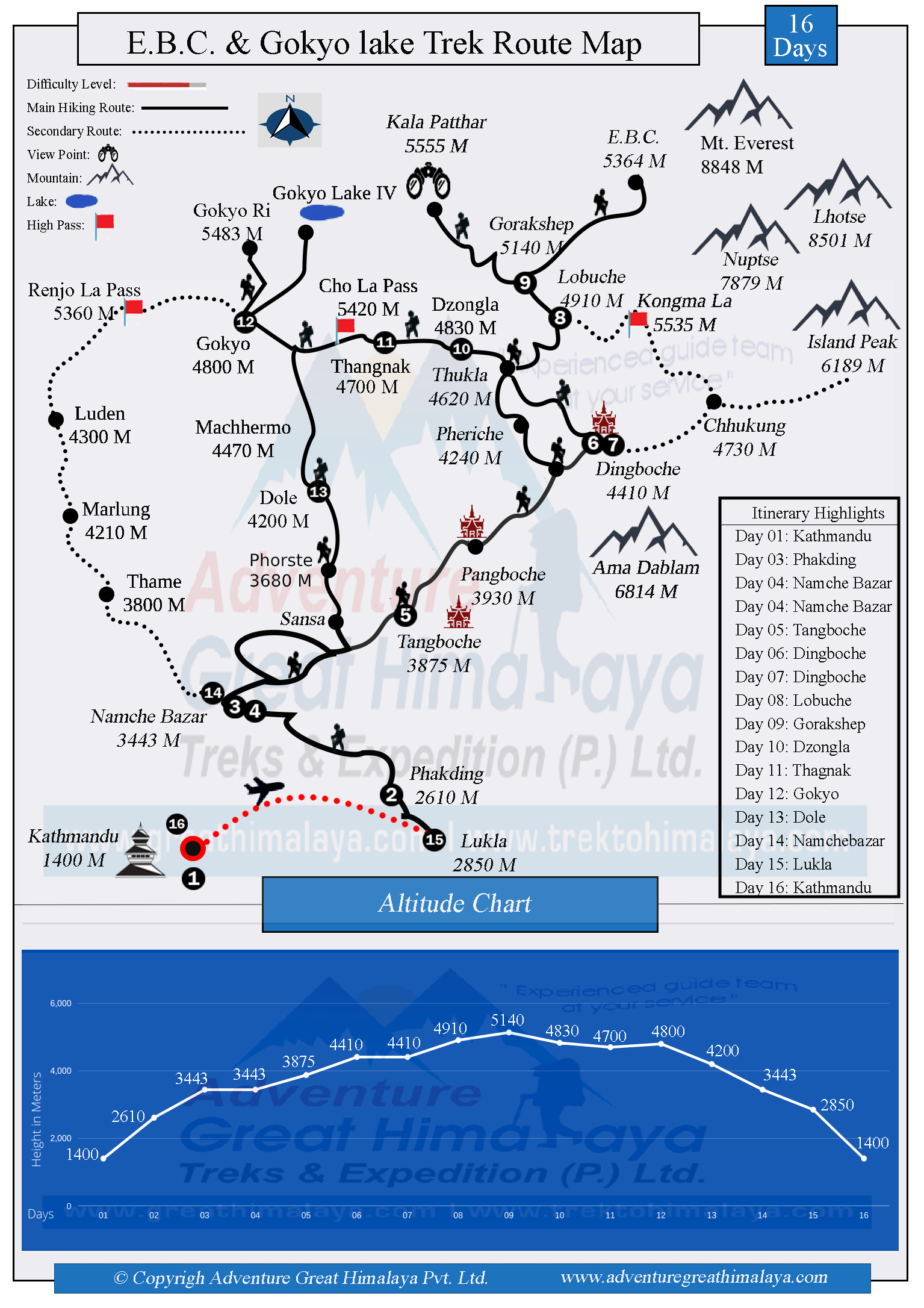
Gallery
